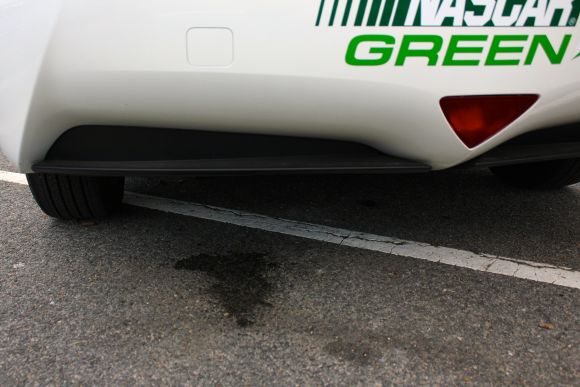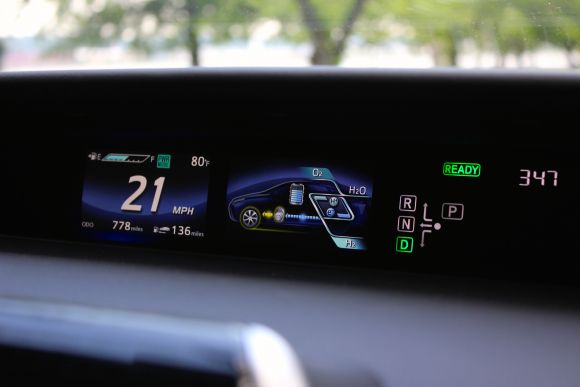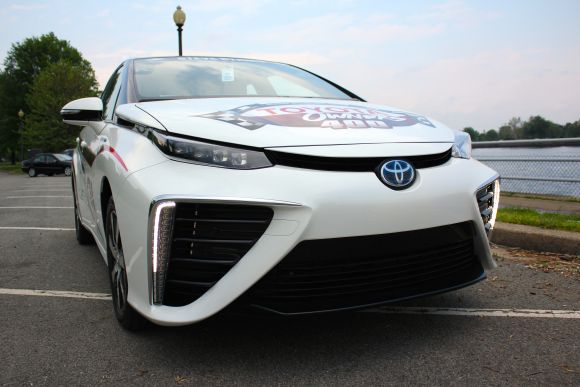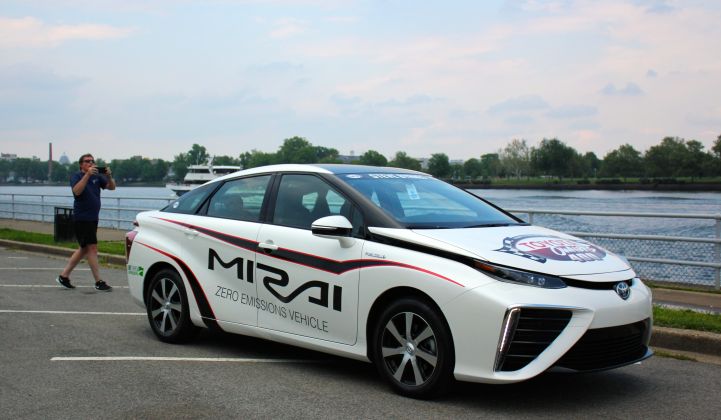Something you can’t help but notice while driving around in Toyota's new fuel-cell car, the Mirai, are all of the stares from people on the street.
The racing stickers on the Mirai I rode in last week -- one of just 10 in the United States right now -- probably didn’t hurt in terms of drawing attention.
“That is one sexy car,” said Brad Hopkins, an Uber driver in Washington, D.C., who took a break from his run to snap a photo of the Mirai while it was parked in Arlington, Virginia.
Looks aside, there are several inescapable drawbacks to fuel-cell vehicle (FCV) technology, as many cleantech experts, including GTM contributor Tam Hunt, have pointed out.
Battery electric vehicles are more efficient than FCVs and would arguably fit more easily into a low-carbon, distributed energy system running on solar, stationary batteries and advanced software. It’s a future Tesla’s Elon Musk is working toward.
Toyota’s big bet is that the average consumer just isn’t ready for the behavior change that goes along with the battery electric car. For Toyota, a company that overcame doubters to popularize the Prius hybrid, the FCV is the vehicle of choice for the next century.
The Mirai (which means “future” in Japanese) was 20 years in the making. Now, like it or not, the Mirai and similar fuel-cell vehicles are coming to market. And they might get pretty good market traction.

Passerby Brad Hopkins takes a photo of the Mirai in Arlington. Credit: Julia Pyper
The Toyota Mirai’s front air vents, lined with LED headlamps, are one of the vehicle’s most notable features. Functionally, they serve to bring oxygen into the fuel cell, where it is mixed with hydrogen to create electricity. Aesthetically, they’re polarizing -- depending on your perspective, they either look distracting or sleek and modern.
Toyota developed many of the key components of the vehicle’s power train in-house, including the Mirai’s high-performance polymer electrolyte fuel cell with a 100-kilowatt output. Toyota also developed the two carbon-fiber-reinforced hydrogen tanks to feed the fuel cell, which collectively hold 5 kilograms of hydrogen at 10,000 psi.
With this technology, the Mirai can to get up to a 300-mile range, refuel in 5 minutes with an easy-to-use nozzle, and give drivers a zippy ride while emitting only water out of the tailpipe.
For an additional cost (still yet to be determined), the Mirai can also provide stationary power through a port located in the trunk of the vehicle. With full tanks, the Mirai can generate enough electricity to power the average Japanese home (approximately 7 kilowatts) for about a week. This feature could be useful during a major power outage or natural disaster, although once the hydrogen runs out, it will be difficult to replace.

Water from the Mirai tailpipe. Credit: Julia Pyper
With the hope of boosting interest in fuel-cell technology, Toyota released approximately 5,680 of its fuel-cell-related patents earlier this year -- free of charge. The stash includes nearly 2,000 patents on fuel-cell stacks, 290 related to high-pressure hydrogen tanks, 3,350 related to system software controls and 70 patents related to hydrogen production and supply.
While the Mirai represents a technological breakthrough, not everything in the vehicle is new. Toyota appropriated the FCV’s electric motor from the Lexus hybrid. The Mirai is also equipped with a nickel-metal-hydride battery -- the same battery used in Toyota’s Camry hybrid -- that is used for regenerative braking.
On the inside, the Mirai comes with many of the features of a higher-end sedan, including intelligent touch controls, heated seats and a premium audio system. It’s also equipped with premium safety features, including blind-spot monitoring, parking assist, lane-keep assist and a collision warning system.
When it comes to the actual driving experience, the Mirai is like any other car, save for a distinct electric hum during acceleration. Arguably, the fact that there’s nothing new about the driving experience is the vehicle’s best asset.
The familiarity factor shouldn't be underestimated. There is considerable value from replicating the driving experience consumers are accustomed to with gasoline-powered cars, while giving them the feel-good benefits of powering their vehicle with a low-carbon, domestically produced fuel.
U.S. consumers place a high priority on convenience. Only in 2009 did American car buyers decide fuel economy was more important vehicle feature than cup holders.
“It’s all about the potential for making larger vehicles that go farther and refuel quickly, while keeping the driver’s habits the same,” said Chris Santucci, program manager for Toyota’s energy and environmental research group.

The Mirai dashboard shows drivers when the fuel cell is working and how eco-friendly they're driving. Credit: Julia Pyper
It's early days, but so far Toyota has successfully drummed up some real interest in the vehicle. By the time the Mirai launched in Japan on December 15, 2014, Toyota had already racked up 1,500 orders. Toyota’s initial allotment was for 700 vehicles, 400 of which were earmarked for Japan. In response to strong demand, Toyota invested $165 million last year to triple production capacity of the Mirai.
According to Toyota, around 60 percent of the first orders were from Japanese businesses and government fleet customers. The remaining 40 percent were from private buyers in Japan, who each put down $62,150 to own the FCV.
This fall, the Mirai will go on sale at select dealerships in California for $57,500 or will be available for lease at $499 per month for 36 months -- both options include free fueling for up to three years. FCVs in California also qualify for a $5,000 tax credit; the $8,000 federal tax credit for FCVs expired at the end of 2014.
Toyota is targeting to sell 3,000 units in the United States by the end of 2017. And then hundreds of thousands more after that.
“Toyota is serious about it,” said Santucci. “They see it as the powertrain for the next 100 years.”
Several other major automakers, including Honda, Hyundai and Mercedes, are also making serious bids to bring commercial FCVs to market, with support from the California Energy Commission, the Department of Energy, universities, environmental groups, established hydrogen producers and startups.

The Mirai's distinctive front air vents. Credit: Julia Pyper
It’s hard to ignore such a large, coordinated commitment to a new technology like this. It’s also hard to ignore the criticisms.
For one thing, hydrogen production is an inefficient and energy-intensive process, particularly when compared to generating electricity for direct use in plug-in cars. Also, public fueling infrastructure is very limited, with just 10 stations in California and two on the East Coast. Plus, those stations are expensive to build at $1 million to $2 million apiece.
For these and other reasons, Elon Musk called fuel-cell vehicles “bullshit.”
Toyota attempted to address this criticism head-on in a new ad for the Mirai called “Fueled by Bullsh*t,” which shows how hydrogen can be made using cow dung as a feedstock. (The tagline could be turned back around on Toyota for ignoring that the steam reformation process that turns cow waste into hydrogen fuel is incredibly energy-intensive, and so the whole process isn’t quite as eco-friendly as it seems.)
However, assuming a fair number of American drivers aren’t willing to change their driving habits in order drive a battery electric car, maybe it’s not the worst idea?
“From an engineering standpoint, it’s resourceful,” said Santucci.
Plus, 95 percent of the hydrogen produced today comes from natural gas through the refining process, added Santucci. With abundant natural-gas supplies in the U.S., FCVs can run on a domestically sourced fuel, “and I think that’s pretty important for the country,” Santucci said.
Toyota’s Senior VP Bob Carter fired back at Musk at the J.D. Power Automotive Summit earlier this year, criticizing Tesla’s singular focus on battery electric vehicles. "If I was in a position where I had all my eggs in one basket," he said, "I would perhaps be making those same comments.”
The fact that Toyota discontinued the RAV4 EV that was created in partnership with Tesla could be another source of tension, or perhaps the result of tension, between the two companies.
It’s easy to pit FCVs against plug-in electric cars -- they’re both advanced vehicle technologies competing for government dollars and for early adopters. But does there have to be a loser?
Yes, FCVs are less efficient than pure EVs, but they’re both more efficient than gasoline-powered cars. There are also tangible benefits to reducing local tailpipe pollution and switching to domestically produced transportation fuels. For FCVs, that means using natural gas to make hydrogen, or using excess renewable energy to power hydrogen production through electrolysis.
And maybe they’re not really competing for early adopters, either. The FCV driver could be someone who wants to get away from gasoline, but simply doesn’t have the space or the lifestyle to plug in an electric car, and so wouldn’t be buying one anyway.
The executives and engineers at Toyota must be thinking along these lines. If their bet on fuel cells pays off, the company will be miles ahead of the competition.



